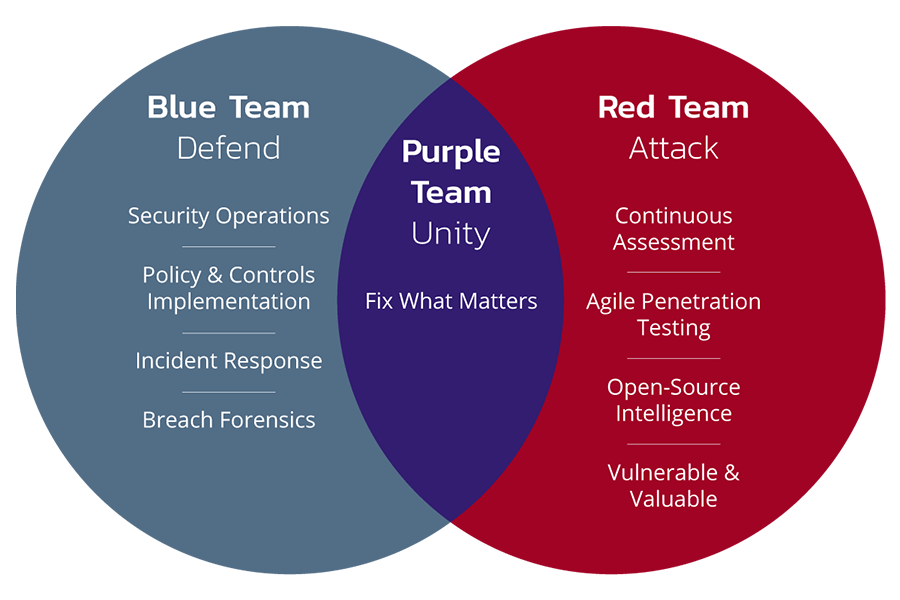PRACTICAL CYBERSECURITY: CISOs MUST SET UP THEIR PURPLE TEAM.

PRACTICAL CYBERSECURITY: CISOs MUST SET UP THEIR PURPLE TEAM.
Red and blue teaming are well-established concepts in information security, but recent years have given rise to a more collaborative approach – purple teaming.
To defend against rapidly evolving cyber threats, businesses need to continually adapt and innovate. This means that red and blue teams must work together on an ongoing basis to maximize their individual and collective impact.
Red vs blue teams – what’s the difference?
A red team is a group of offensive security professionals tasked with using real-life adversarial techniques to help organizations identify and address vulnerabilities across infrastructure, systems and applications, as well as weaknesses in processes and human behavior.
In contrast, a blue team, typically based in a Cyber Security Operations Centre (CSOC), is a group of analysts and engineers responsible for defending organizations from cyber-attacks through a combination of threat prevention, deception, detection and response.
Implementing a joint approach
Regardless of size, industry or resources, all organizations need red and blue team expertise to effectively combat cyber threats.
Red team activities, from vulnerability assessments and penetration testing to full-scale cyber-attack simulations, are specifically designed to identify security exposures by challenging blue teams and assessing detection techniques and processes.
Red team assessments can be used to test organizations against the latest tools, tactics and procedures used by criminal adversaries, and provide vital feedback to improve threat hunting, monitoring and incident response.
The reality for many organizations, however, is that red and blue teams are often separate and disconnected entities. In some small organizations, for example, in-house IT staff are often tasked with monitoring, detection, and response, while ethical hackers are commissioned by external providers to perform occasional vulnerability scanning and penetration testing services.
This means that there are frequently no continuous feedback channels between red and blue teams. Rather than collaborating and continuously enhancing security controls, many organizations are adopting a short-term view to security and failing to leverage red and blue team insight to inform and evaluate long-term security goals and strategy.
What is purple teaming?
Purple teaming is a security methodology in which red and blue teams work closely together to maximize cyber capabilities through continuous feedback and knowledge transfer.
Purple teaming can help security teams to improve the effectiveness of vulnerability detection, threat hunting and network monitoring by accurately simulating common threat scenarios and facilitating the creation of new techniques designed to prevent and detect new types of threats.
Some organizations perform purple teaming as one-off focused engagements, in which security goals, timelines and key deliverables are clearly defined, and there is a formal process for evaluating lessons learned over the course of an operation. This includes recognizing offensive and defensive shortcomings and outlining future training and technical requirements.
The benefits of purple teaming
Enhance security knowledge
Being able to observe and participate in attacks gives the blue team a better understanding of how attackers operate, enabling them to more effectively employ technologies to deceive actual attackers and study their tactics, techniques, and procedures (TTPs).
Boost performance without increasing budget
Combining defense and offence through purple team exercises allows organizations to improve security monitoring function faster and at less cost.
Streamline security improvements
An alternative approach within the security industry is to view purple teaming as a conceptual framework that runs throughout an organization. This can nurture a collaborative culture that promotes continuous cyber security improvement.
Gain critical insight
Purple teaming gives your internal security team a critical understanding of gaps in your security posture and helps to identify areas for capability enhancement.
How SMSAM SYSTEMS Help To Setting Up Your Purple Team.
Join our exclusive webinar to find out.
Exclusive Webinar: PRACTICAL CYBERSECURITY: Why Your Organization Should Consider Setting Up Its Own Purple Team.
Webinar Details Below;
Date: 27th October 2021
Time: 2PM (Nigeria), 16:00 EAT & 14:00 GMT
Zoom Registration Link: https://us02web.zoom.us/j/86595605766?pwd=Y1k0TWZYd1VZemdQV2EybmRSZnlXQT09
Meeting ID: 865 9560 5766
Passcode 844772
